Inflation's a Bitch: What Food Costs in Buenos Aires Right Now
Is Buenos Aires still an affordable destination? Not in this economy. Here’s what you’ll pay for food, as of February 2025.
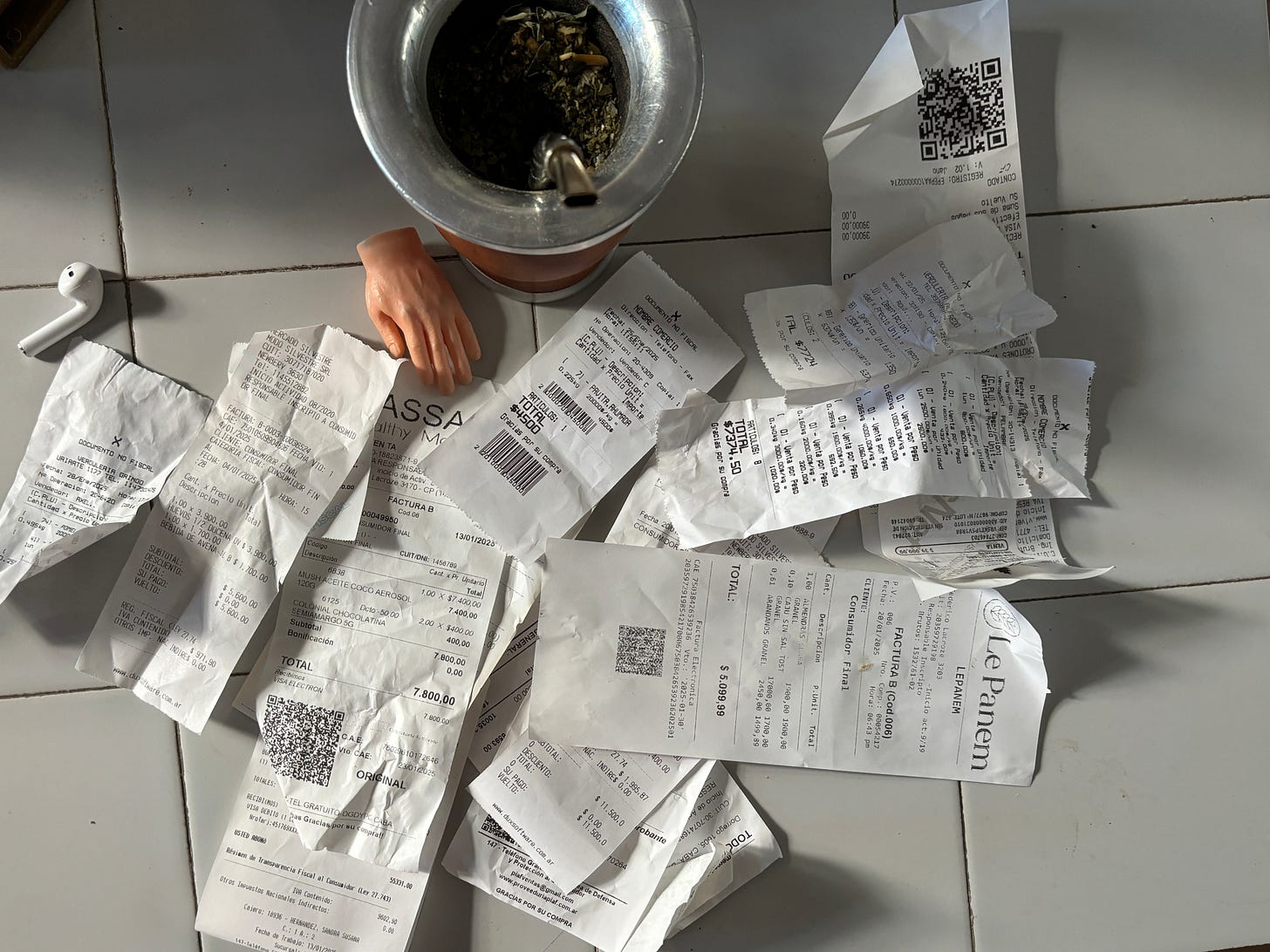
A few days ago, a friend who used to live in Buenos Aires reached out to say he was coming back to visit. He mentioned he was trying to rent the same two-bedroom Palermo Hollywood PH he’d stayed in during 2023 and was shocked to learn the price had jumped from $650 USD a month to $1,000.
“Is this guy tripping?” he asked.
“Nope,” I replied, sorry to be the bearer of bad news. “Buenos Aires got a lot more expensive.”
The last time he was here, Buenos Aires was a budget traveler’s dream. Food costs were so low, I’d watch out-of-towners order entire menus at fancy restaurants without even glancing at the prices. Just a year ago, in my article for Eater’s “38 Essential Restaurants in Buenos Aires,” I wrote, “Most people carrying USD will find restaurants to be affordable.” Back then, even with rampant inflation, the U.S. dollar stretched far, and dining out was an incredible deal. Today? Not so much. Many of those prices have doubled—or even tripled.
Finding affordable food can be a challenge, and a casual night out feels less like a whim and more like a financial commitment. Just the other night, I went out for fast food and paid nearly $20 USD for a burger, fries, and a gaseosa.
It’s not just dining out—everyday food costs have skyrocketed. Grocery shopping has become a game of strategy, with prices shifting unpredictably. Personally, I’ve completely reevaluated my grocery list. Items like Greek yogurt ($7) and almond milk ($5) have become luxuries. I’ve swapped brands, changed my shopping habits, and cut back on everyday indulgences like cheese (insert sad emoji). Even olive oil and coffee feel like splurges these days.
Now, I don’t want to become one of those people who partake in the beloved pastime of price complaining, but here we are. This kind of economic instability isn’t anything new—we’ve been through this before in BA. Still, it’s hard to adapt when prices shift so dramatically, so quickly.
Cost Breakdown: Buenos Aires, February 2025
To give you a better sense of what’s actually going on right now, I tracked my food expenses over the past few weeks. Here’s a snapshot of everyday food prices based on what I’ve spent in the first weeks of 2025—plus a few items I wanted to buy but ended up putting back on the shelf (womp womp). Prices can (and will) change, especially depending on where you shop, but this should give you a solid idea of the current cost of food living as of February 4, 2025.
Official exchange rate: $1 USD = 1074 ARS
Blue dollar rate: $1 USD = 1220 ARS
Carnicería (Butcher Shop) – (from Piaf or Ummah Halal)
Chicken breast (1 kg): $9500 ARS
Chicken leg & thigh (1 kg): $2900 ARS
Chicken milanesas (1 kg): $9800 ARS
Paleta (beef shoulder, 1 kg): $8700 ARS
Bife de chorizo (sirloin, 1 kg): $15200 ARS
Chorizos (1 kg): $8500 ARS
Pescadería (Fish & Seafood)
I rarely buy fish or seafood anymore because it’s expensive and the quality isn’t great. But if you need it, check Casa China’s website for current prices.
Verdulería (Vegetable Shop)
Tomatoes (1 kg): $1000 ARS *currently in season
Sweet potatoes (1 kg): $2000 ARS
Bananas (1 kg): $3000 ARS
Pink grapefruit (1 kg): $2000 ARS
Avocado (each): $1500 ARS
Garlic (head): $2000 ARS
Carrots (1 kg): $1800 ARS
Peaches (1 kg): $4800 ARS
Lettuce (1 kg): $2800 ARS
Kale (1 pack): $1500 ARS
Onions (1 kg): $800 ARS
Corn (3 each): $2500 ARS
Potatoes (2 kg): $1500 ARS
Blueberries (1 package): $2000 ARS
Pre-made salad: $2500 ARS
Frozen berries (500 g): $7500 ARS
Dietética / Snacks / Pantry Staples
Plain regular yogurt (190 g): $1900 ARS
Greek yogurt (290 g): $7680 :(
Butter (100 g): $2000 ARS
Olive oil (500 ml): $16000 ARS
Organic honey (440 g): $5800 ARS
Toasted almonds (100 g): $1900 ARS
Dried cranberries (100 g): $2200 ARS
Tortilla chips (Orale brand): $5600 ARS
Chocolate-covered pretzels: $3500 ARS
Berry jam (295 g): $8300 ARS
Peanut butter (350 g): $4650 ARS
Protein bar: $1500 ARS
Country brown eggs (1 dozen): $5600 ARS
Sushi or Fortuna rice (1 kg): $4200 ARS
Quinoa (250 g): $2300
Pasta national brand (500 g): $1200 ARS
Flour (1 kg): $1200 ARS
Tuna (120 g can): $2800 ARS
Canned tomatoes: $1800 ARS
Maruchan ramen: $2000 ARS
Sliced turkey fiambre (200 g): $4500 ARS
Good coffee beans (250 g): $18500 ARS
Rice paper (500 g): $5800 ARS
Psyllium husk: $8040 ARS
Tofu (450 g): $4000 ARS
Feta cheese Juan Grande (400 g): $31600 ARS
Prepared Foods
Personal pizza (from one of these pizzerias): $16000 ARS
Empanada (each): $2000 ARS
Sandwich (basic but good, local shop): $8000 ARS
Sourdough bread (bakery loaf): $4200 ARS
Medialuna (each): $2400 ARS
Chipa (from bakery): $4200 ARS
Ice cream (1 kg): $13000 ARS
Coffee, juice, medialuna promo: $5600 ARS
Beverages
Milk (1 liter): $1700 ARS
Almond milk (1 liter): $5200 ARS
Oat milk (1 liter): $1700 ARS
Orange juice (1 liter): $3000 ARS
Stella Artois Beer (1-liter bottle): $4300 ARS
Coke (1.75 liters): $3000 ARS
Wine (decent bottle): $15000 ARS
Cynar (750 ml): $7500 ARS
Iced Americano or Flat White (specialty café): $3800–$6000 ARS
Imported Items
Sriracha (793 g): $18200 ARS
Barbecue sauce (Sweet Baby Ray’s): $10000 ARS
Heinz ketchup: $9500 ARS (bottle) / $2300 ARS (sachet)
Gochujang paste (500 g): $12500 ARS
Teriyaki glaze (340 g): $14300 ARS
Barilla pasta: $7800 ARS
Tahini: $13000 ARS
Tabasco sauce: $10400 ARS
Kewpie Mayo (450 g): $11300 ARS
Haribo gummies (160 g): $4550 ARS
Peanut M&Ms (small pack): $2550 ARS
Philadelphia cream cheese (150 g): $6400 ARS
Maple Syrup (250 ml): $14200 ARS
Coconut Milk (400 ml): $5600 ARS
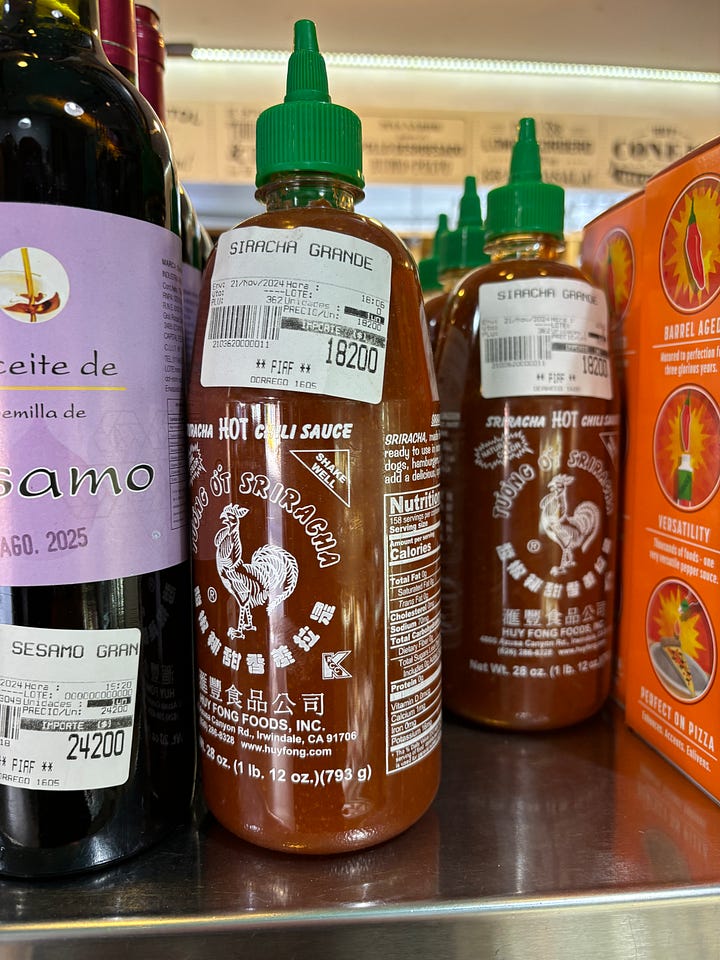
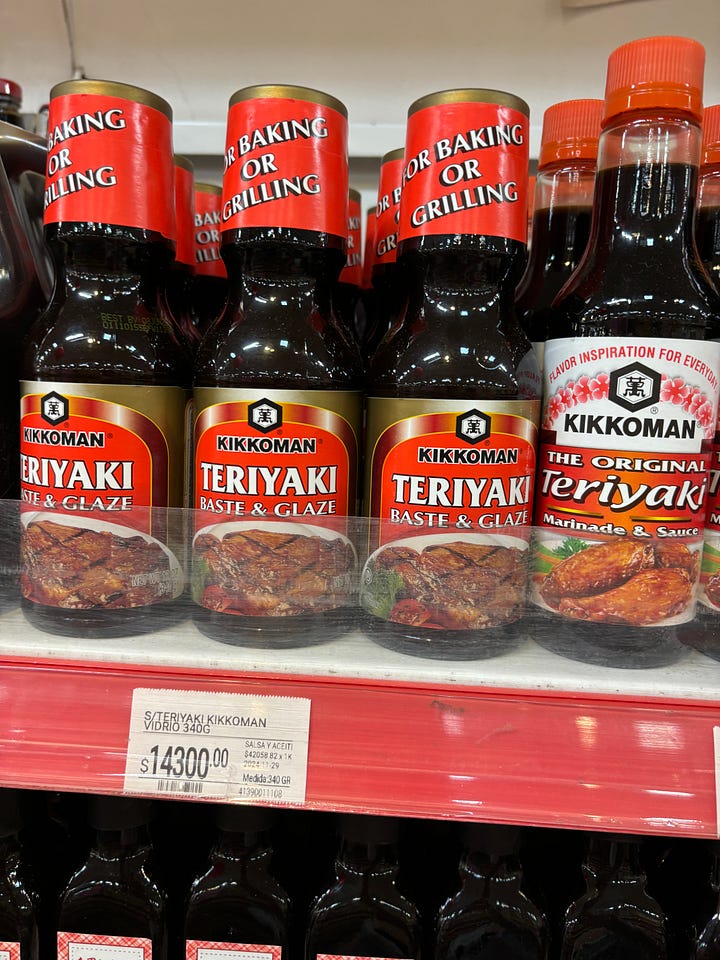
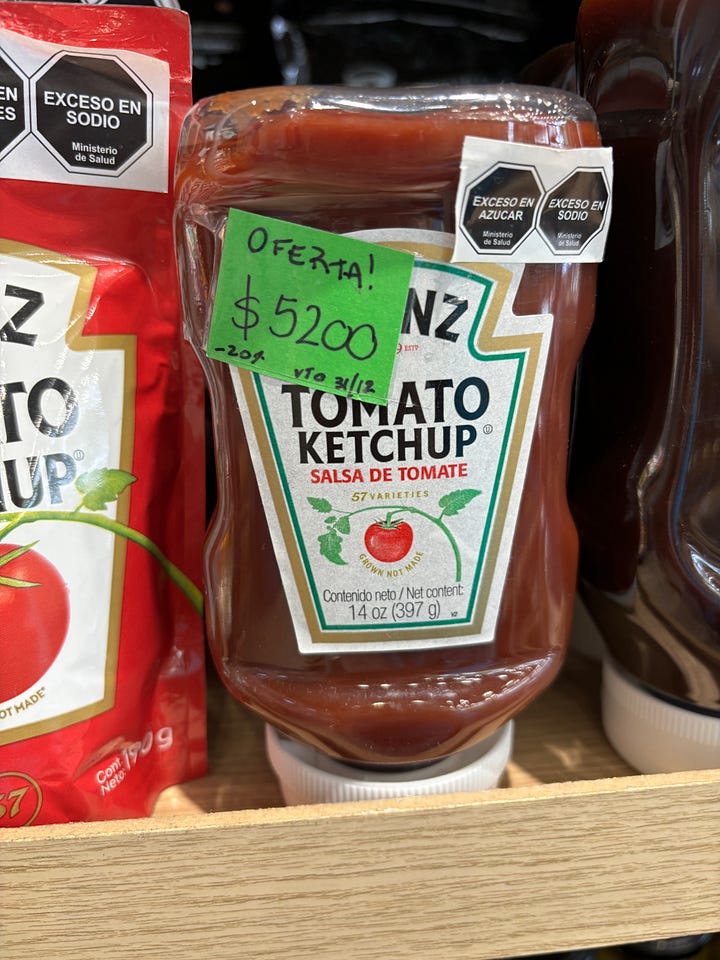
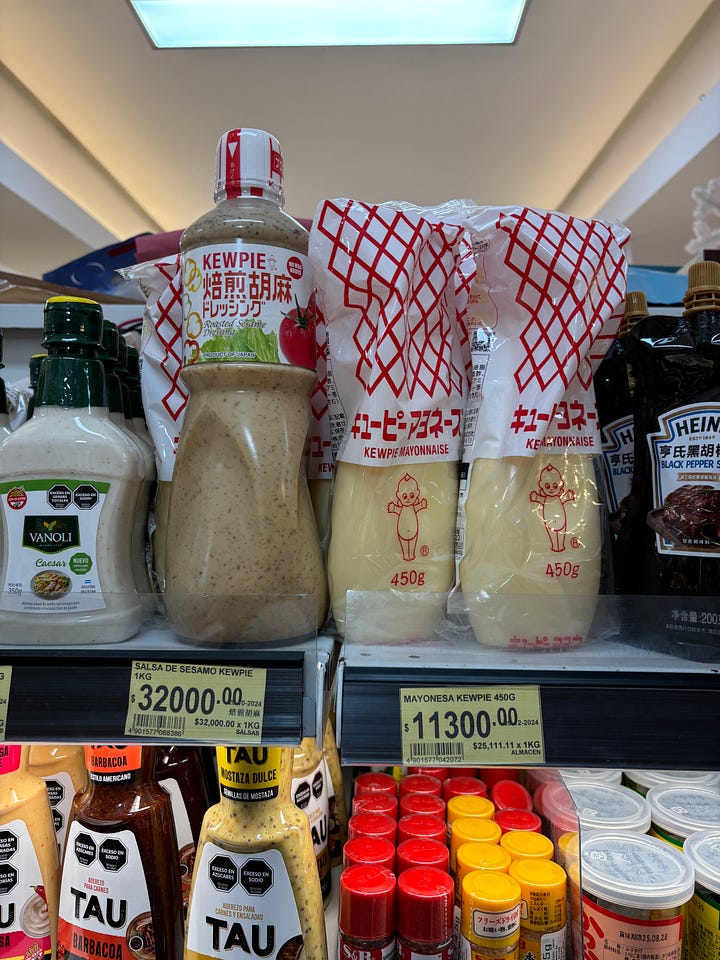
Final Takeaways:
Sticker Shock is Real: Lately, my algorithm has been flooded with TikToks of travelers reacting—often dramatically—to Buenos Aires prices. Maybe you’ve seen the Spanish girls at Zara in disbelief or the digital nomad complaining about an $18 pre-cut fruit salad in Palermo Chico. It’s hard not to chuckle at some of their reactions—maybe check a price tag before buying? Or, I don’t know, buy seasonal fruit from a normal barrio verdulería and cut it up yourself for a fraction of the cost? But their shock isn’t entirely unwarranted; Buenos Aires was a budget-friendly haven not long ago, and most resources online reflect that reality. Prices have shifted—fast—and for everyone.
Grocery Store Strategy: Gone are the days of tossing items into the cart without thinking. Now it’s more like strategic budgeting: Do I really need Greek yogurt this week, or can I DIY it? Is that imported hot sauce actually better than a cheaper locally made brand? Should I reduce my coffee intake and become a mate drinker? (The answer is yes). This shift isn’t just about cutting luxuries—it reflects a broader trend where many households are recalibrating their shopping habits.
Inflation Whiplash: Prices change so quickly that something you bought for $2,000 ARS last week might be $4,500 ARS today, or on promo next week because it’s not selling. According to La Nación, meat prices alone are expected to rise another 5–7% in the coming weeks due to supply issues and economic shifts. Of course, if you are familiar with Argentina, this is business as usual.
Dining Out Feels Different: What used to be a spontaneous dinner with friends now comes with a price tag that feels more like a fine-dining splurge than a casual night out. As prices rise and the middle class shrinks, many people are dining out less frequently. A lot of my friends, for example, now prefer home-cooked meals to manage costs—where we once met at restaurants, we’re gathering at each other’s homes and cooking instead. This shift has pushed restaurants to adapt: some cater primarily to a “¿de qué viven?” demographic, while others struggle to stay afloat.
Economic Tug-of-War: Under President Javier Milei, Argentina’s economic policies have aimed to control inflation, with projections suggesting it could drop from triple digits in 2023 to around 20.6% annually in 2025—a significant decrease. Supporters argue these reforms are essential for long-term stability. However, critics point out the human cost: poverty rates have surged, with over half the population now living below the poverty line. So yes, inflation may be “under control”—but at what cost and for who?
Living Wages, Unlivable Reality: Even as prices soar, wages for many remain stagnant. A bachero (dishwasher) in a top “50 Best” Palermo restaurant earns around 1 million ARS per month, while a head chef makes roughly 1.5 million ARS, plus tips. When basic groceries, rent, and transportation eat up most of that income, how does anyone manage? *Note: I’ve been asking this same question for nearly two decades.
Debating the New Normal: Some argue that food and restaurant prices in Buenos Aires were unrealistically cheap for years and are now “catching up” to global standards. And while that is true, unlike cities like New York, Tokyo, or Barcelona, Buenos Aires lacks any affordable food options. There’s no real equivalent to fast food dollar menus, budget-friendly tapas happy hours, or cheap and delicious street eats. Finding a meal under $20 feels like a scavenger hunt.
Privilege Check: Yes, the quality of life for many has shifted under this new reality. Personally, I’ve had to tighten my budget, especially as I transition from full-time work to freelance. But for many people here, it’s not just about cutting back on luxuries—it’s about affording rent, health insurance, covering basic necessities, and putting food on the table. While I can adjust my spending habits, for others, these rising costs force impossible choices, where even the essentials become out of reach.
And for my last thought… Buenos Aires may cost more now, but its magic? Still priceless.









Ok, this is great like every other article you've been writing these weeks, but my inner economist (and one particularly passionate about Argentina’s never-ending economic experiments) can’t help but make a few observations:
1) I don’t think describing the situation as “prices changing so quickly” is quite accurate when it comes to Argentina nowadays, especially given the country’s historical (and recent) context in this regard. While there are still some relative price adjustments happening, particularly in Buenos Aires, where regulated prices were lagging far behind their real levels, both volatility (rapid price fluctuations) and dispersion (different prices for the same item just a block away) have really plummeted last year compared to the chaos I witnessed in Buenos Aires in 2022 and 2023.
2) On poverty: yes, technically poverty might have risen to affect half the population, but it’s a bit misleadng. The big inflation shock of the first months, driven by the last government’s massive monetary stimulus, exposed the reality that had been hidden under the rug. However, poverty nowcasts from well-known and not particularly pro-government economists show that poverty levels are already below the last numbers published by the Fernández administration. This makes sense, especially given the sharp decline in inflation. And I don’t want to fuel Milei’s megalomania, but if he manages to pull this off, it will definitely go down in economic history books.
3) Regarding a comment from Bárbara Vallejos (is there a way to tag here?): the "indices" are from 2024 (and now 2025), not from 2004. While the weights used to construct the "indices" are from 2004, it really doesn't affect the index that much and they’re useful for following the trend (which is what we’re trying to capture), since are the same ones that have been used in recent years. Adjusting them now wouldn’t really makes sense from a statistical point of view.
We shouldn’t forget that inflation is an average, not just of different prices but also of different regions. It may be true that people in Buenos Aires are bearing the brunt more, given that regulated prices were lower there, but that doesn’t mean the inflation index is useless or doesn’t reflect the broader reality.
Esta muy bueno el articulo, quizás me hace ruido el ''buenos aires budget friendly 2023'' la realidad es que era budget friendly para el que ganaba en dolares mas que todo, por eso era el destino soñado, pero la gran mayoría ganábamos en pesos y la inflación también nos estaba destrozando. Era una burbuja que en cualquier momento iba a explotar (y lo hizo)